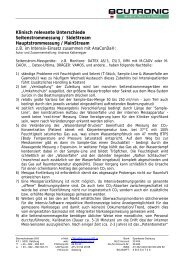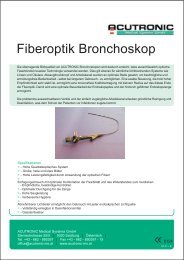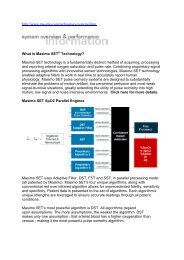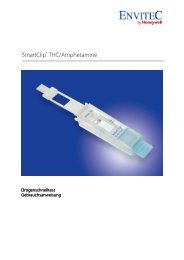Summary Carbon Monoxide Lurking within: The Danger of ...
Summary Carbon Monoxide Lurking within: The Danger of ...
Summary Carbon Monoxide Lurking within: The Danger of ...
Create successful ePaper yourself
Turn your PDF publications into a flip-book with our unique Google optimized e-Paper software.
masimo corporation 40 parker irvine ca 92618 www.masimo.com<br />
Demystifying Carboxyhemoglobinemia - ED<br />
<strong>The</strong> Guessing Game<br />
CO poisoning is the leading cause <strong>of</strong> death by poisoning in industrialized countries 1 and<br />
may be responsible for more than half <strong>of</strong> all fatal poisonings worldwide. 2 It is estimated that<br />
approximately 43,000 emergency room visits are attributed to CO poisoning in the United States<br />
each year. 3 At least 3,800 people die annually in the U.S. from the effects <strong>of</strong> CO poisoning,<br />
and 1,400 <strong>of</strong> these deaths are accidental. 4-5 Unfortunately, for most patients poisoned by the<br />
colorless, odorless, tasteless gas, CO poisoning is not the immediate and obvious diagnosis.<br />
Variable symptoms, a wide range <strong>of</strong> patient sensitivity and unsophisticated detection systems<br />
<strong>of</strong>ten result in misdiagnosis and treatment delays.<br />
Rapid Determination <strong>of</strong> <strong>Carbon</strong> <strong>Monoxide</strong> Poisoning (COHb)<br />
Emergency Departments Acute Care Hospitals<br />
Urgent Care Facilities Point <strong>of</strong> Care – Natural Disaster Zones<br />
Physicians Offi ces Toll Booths / Parking Garages<br />
Inpatient / Outpatient Surgery Centers Airplanes<br />
First – Responders/ Emergency Medical<br />
Services and Fire / Homeland Security<br />
Construction zone<br />
Even in the case <strong>of</strong> Randal McCloy, the sole survivor <strong>of</strong> the Sago Mine tragedy, in which CO<br />
poisoning was the probable cause <strong>of</strong> illness (according to multiple published accounts <strong>of</strong> the<br />
incident), the first physician to attend to the miner reported that McCloy's carbon monoxide levels<br />
were negative. “That means that as best as we can tell with somewhat primitive equipment that<br />
we have here for measuring those, his carboxyhemoglobin levels were negative, indicating no<br />
carbon monoxide in his system, as far as we could tell,” she told reporters.<br />
When pressed for more information, the clinician told the media, “When you put the oxygen<br />
saturation monitor on their finger, it's false [but] it doesn't give you a true reading in somebody<br />
with carbon monoxide poisoning. So you really have to be able to run the blood and check for<br />
carboxyhemoglobin.” In fact, tests run in the subsequent days show McCloy to be suffering from<br />
brain hemorrhaging and edema, muscle injury, liver failure and faulty heart function due to severe<br />
CO poisoning.<br />
Later, physicians at Allegheny General Hospital stated that after receiving three hyperbaric<br />
oxygen (HBO) treatments, McCloy was showing signs <strong>of</strong> improved brain stem and organ<br />
function. MRI scans illustrated the evidence <strong>of</strong> neurological damage but the clinical<br />
consequences remain to be seen.<br />
Some people are more susceptible to longterm<br />
harm from CO exposure than others.<br />
It is possible that the same physiology that<br />
enabled McCloy to survive generally lethal<br />
CO levels for more than forty hours may<br />
also afford him a better clinical outcome<br />
than would be expected. While there are<br />
populations known to be highly susceptible<br />
to the negative effects <strong>of</strong> CO: children,<br />
pregnant women, adults with cardiac<br />
disease, individuals with increased oxygen<br />
demand and patients with chronic respiratory<br />
problems; it is not possible to assess a<br />
person’s CO resilience.<br />
Elevated COHb: Patients at<br />
High Risk for Negative Outcome<br />
Children; elderly<br />
Adults with cardiac disease;<br />
Pregnant women<br />
Patients with increased oxygen<br />
demand or decreased oxygencarrying<br />
capacity;<br />
Patients with chronic respiratory<br />
insuffi ciency.













